S&P500 rises as Nvidia lifts tech, Fed minutes points to more rate cuts ahead
“Bullish measures are getting really bullish.”
This is an interesting statement, given how “bearish” sentiment was in 2022. As I noted then:
“Investor sentiment has become so bearish that it’s bullish.
One of the hardest things to do is go “against” the prevailing bias regarding investing. Such is known as contrarian investing. One of the most famous contrarian investors is Howard Marks, who once stated:
“Resisting – and thereby achieving success as a contrarian – isn’t easy. Things combine to make it difficult; including natural herd tendencies and the pain imposed by being out of step, particularly when momentum invariably makes pro-cyclical actions look correct for a while.
Given the uncertain nature of the future, and thus the difficulty of being confident your position is the right one – especially as price moves against you – it’s challenging to be a lonely contrarian.”
Here is that article’s composite index of retail and professional investor sentiment to visualize just how negative sentiment was then. You will note that sentiment was pushing levels of bearishness not seen since the 2008 “Financial Crisis.”
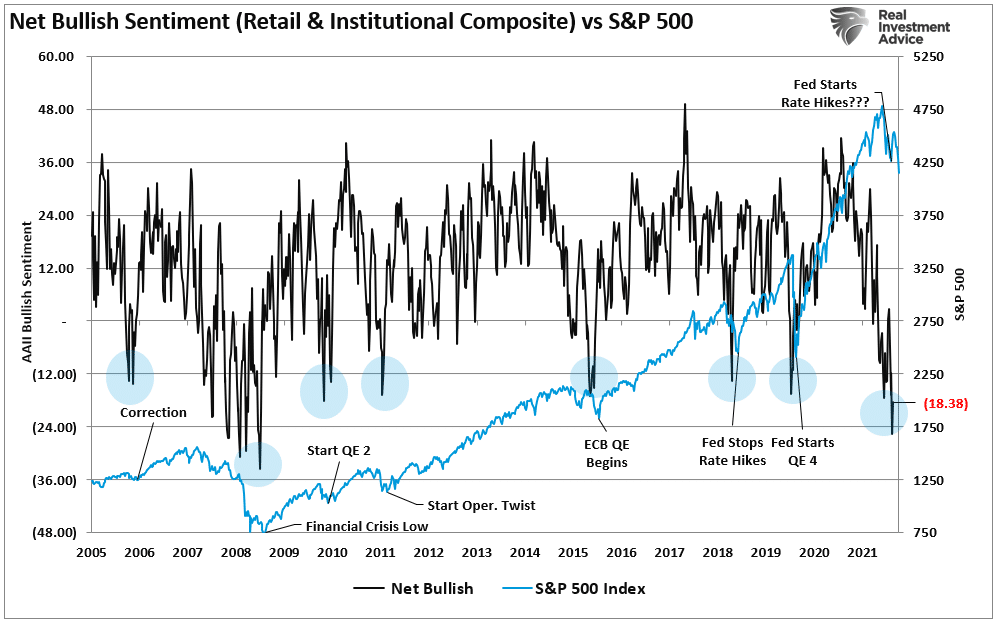 When levels of negativity reach very low levels, such historically equates to short- to intermediate-term market bottoms. Such is because excesses get built with everyone on the same side of the trade. At that time, everyone was so bearish it was a bullish measure. As we stated then, “the reflexive trade will be rapid when the shift in sentiment occurs.”
When levels of negativity reach very low levels, such historically equates to short- to intermediate-term market bottoms. Such is because excesses get built with everyone on the same side of the trade. At that time, everyone was so bearish it was a bullish measure. As we stated then, “the reflexive trade will be rapid when the shift in sentiment occurs.”
Looking back, it is pretty evident such was the case, particularly with the QQQ believed to be dead.
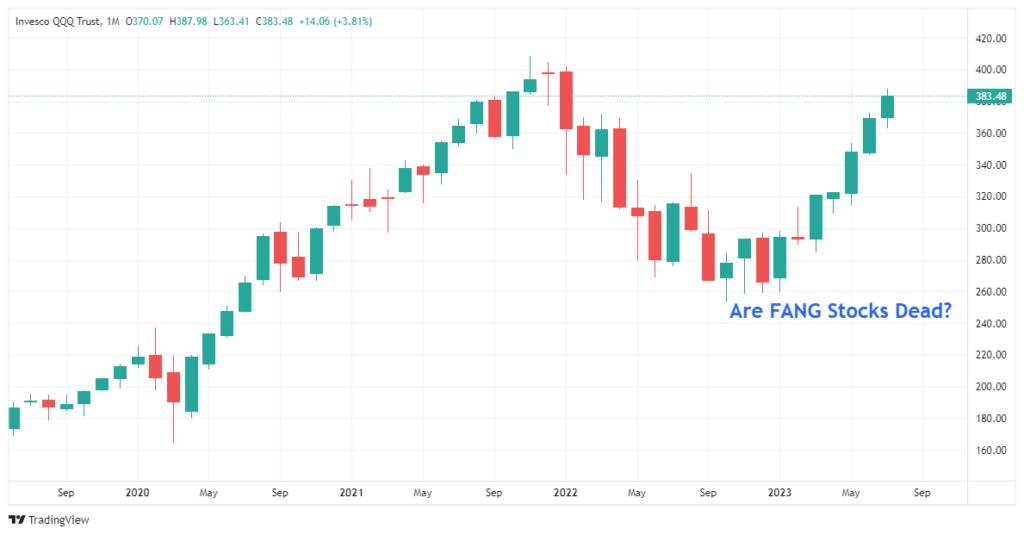
Bullish Measures Are Getting Bearish
Of course, hindsight is always 20/20. Last year there were many reasons to be bearish. Things were seemingly so bad, with everyone expecting a recession, that there was nowhere to go but up. Since October, market participants have been betting on avoiding a recession. Such has led to a sharp reversal in bearish sentiment as the “Fear Of Missing Out,” or FOMO, kicked in.
Since the end of January, despite the Fed hiking rates, a bank solvency crisis, and weakening economic data, the market has continued to “climb a wall of worry.” In fact, not only did it climb a wall of worry.
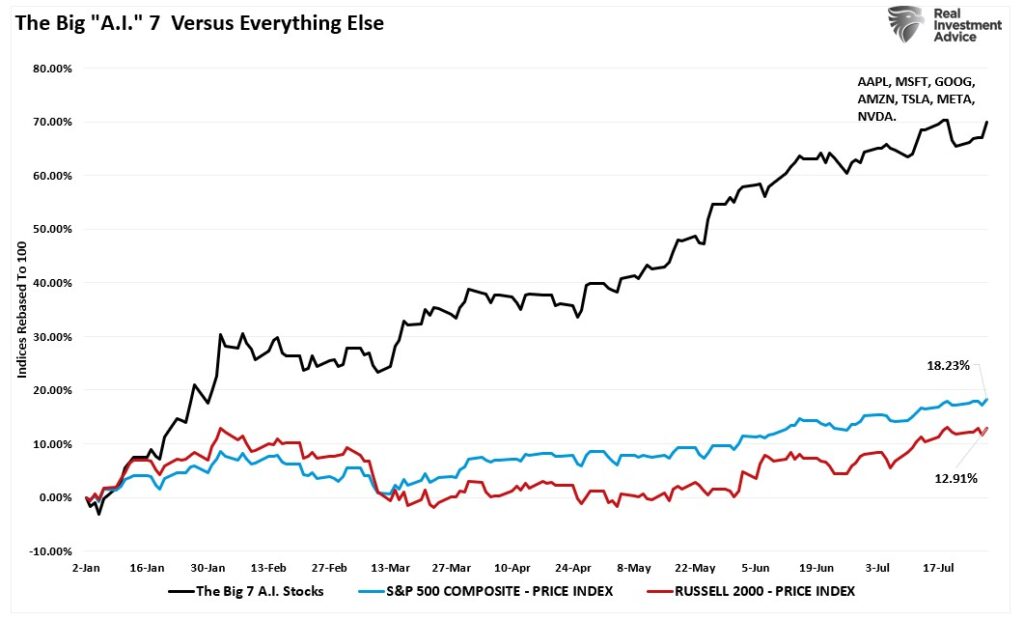 As discussed in this article if it weren’t for the 7-largest market capitalization-weighted stocks in the S&P 500, market returns this year would be substantially lower.
As discussed in this article if it weren’t for the 7-largest market capitalization-weighted stocks in the S&P 500, market returns this year would be substantially lower.
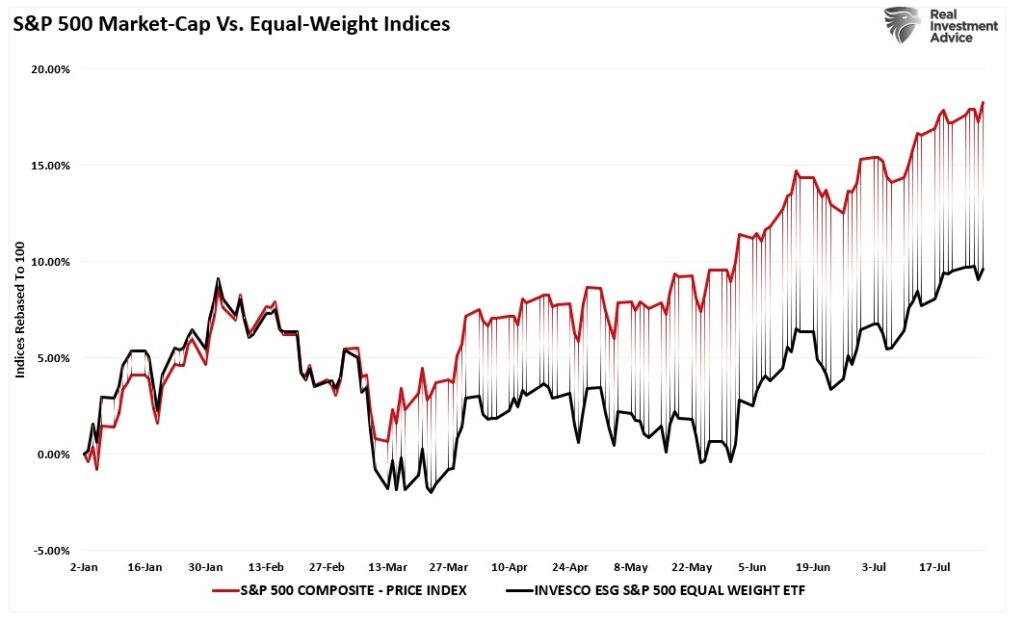 Nonetheless, the surge in the markets reversed that extremely negative bearish sentiment. One measure we look at is the NAAIM sentiment survey of professional investors. This index measures the level of equity exposure of institutional managers every week. Last year, equity exposures were cut near the market lows as managers sold.
Nonetheless, the surge in the markets reversed that extremely negative bearish sentiment. One measure we look at is the NAAIM sentiment survey of professional investors. This index measures the level of equity exposure of institutional managers every week. Last year, equity exposures were cut near the market lows as managers sold.
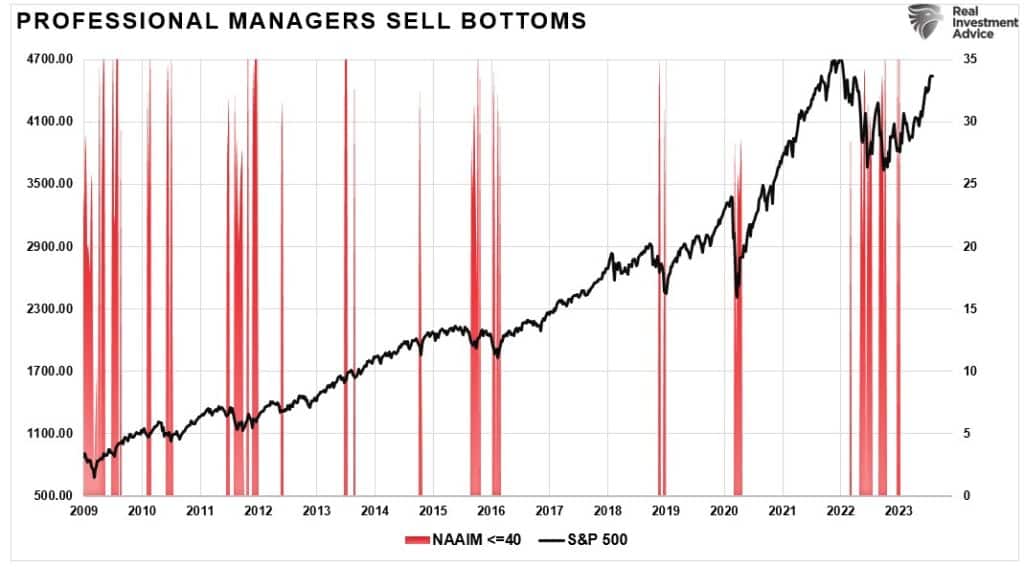 Today, those exposure levels are increasing rapidly. From a contrarian perspective, professional investors have a long history of selling bottoms and buying tops.
Today, those exposure levels are increasing rapidly. From a contrarian perspective, professional investors have a long history of selling bottoms and buying tops.
 However, it isn’t just professional managers piling into the equity market but retail investors also. In 2022, retail investor sentiment also hit extremely bearish levels. As retail investors capitulated and repurchased equities, the market surged higher, rapidly increasing their bullish sentiment.
However, it isn’t just professional managers piling into the equity market but retail investors also. In 2022, retail investor sentiment also hit extremely bearish levels. As retail investors capitulated and repurchased equities, the market surged higher, rapidly increasing their bullish sentiment.
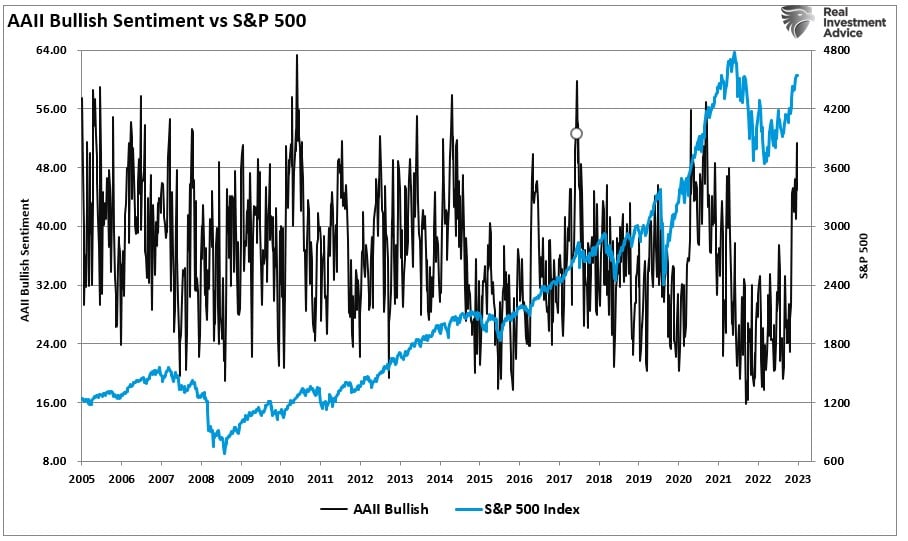 Unfortunately, these more exuberant bullish readings are the antithesis of the bearish readings. While extremely bearish readings tend to denote short-term market bottoms, extremely bullish readings historically suggest short-term peaks.
Unfortunately, these more exuberant bullish readings are the antithesis of the bearish readings. While extremely bearish readings tend to denote short-term market bottoms, extremely bullish readings historically suggest short-term peaks.
A Correction Is Likely
The shift from bearish to bullish sentiment has been steady since the beginning of March. The capitulation of bearish investors continues to push markets higher. Retail and professional investors’ “Net Bullish Ratio,” tells the tale.
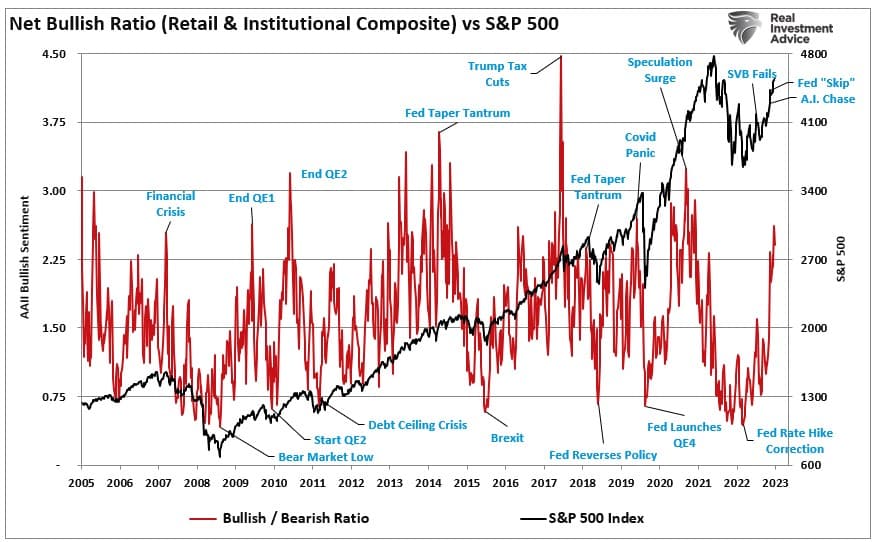 The surge in optimism unsurprisingly resulted in a collapse of market volatility which is also reaching more extreme levels.
The surge in optimism unsurprisingly resulted in a collapse of market volatility which is also reaching more extreme levels.
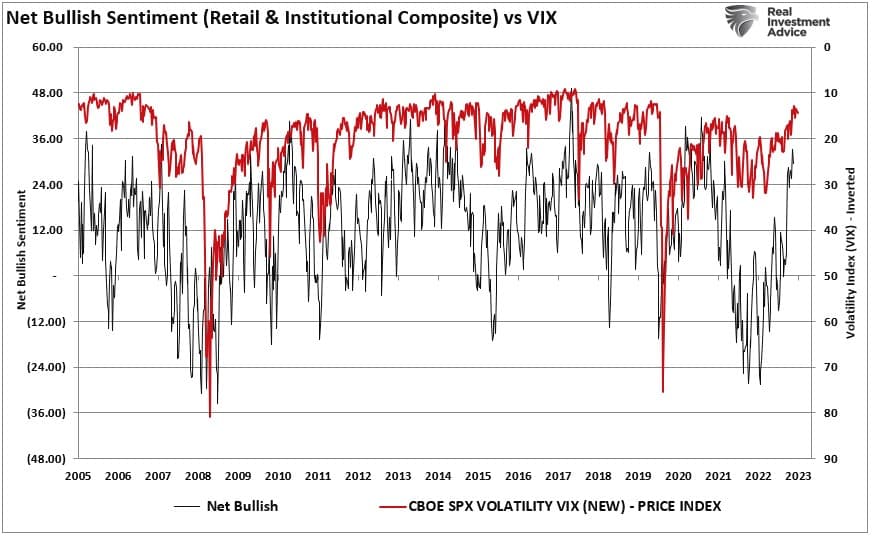 The turn in sentiment resulted from the “pain” felt by investors on the sidelines. While that turn in bullish sentiment is not yet to more extreme levels, it is often the sign of the end of a rally rather than the beginning of one.
The turn in sentiment resulted from the “pain” felt by investors on the sidelines. While that turn in bullish sentiment is not yet to more extreme levels, it is often the sign of the end of a rally rather than the beginning of one.
As a contrarian investor, excesses get built by everyone on the same side of the trade. Previously, everyone was so bearish that the bullish trade higher was inevitable. Today, it is the opposite.
Regardless of your personal views, the bull market that started in October remains intact. However, given the more extreme levels of optimism in the short-term, plenty of evidence suggests a near-term correction is likely. The technically overbought conditions of the market confirm the same.
However, such does not mean selling everything and going to cash.
What I am suggesting is that when “sell signals” are given, individuals should perform some essential portfolio risk management such as:
- Trim back winning positions to original portfolio weights: Investment Rule: Let Winners Run
- Sell positions that are not working (Positions not working in a rising market won’t work in a declining market.) Investment Rule: Cut Losers Short
- Hold the cash raised from these activities until the next buying opportunity occurs. Investment Rule: Buy Low
There is minimal risk in “risk management.” In the long term, the results of avoiding periods of severe capital loss will outweigh missed short-term gains. While I agree you can not “time the markets,” you can “manage risk” to improve long-term outcomes.
